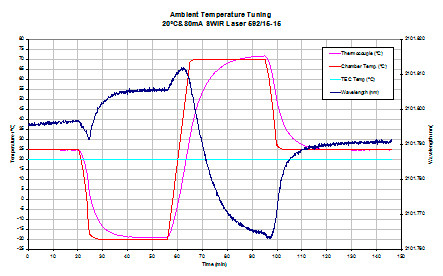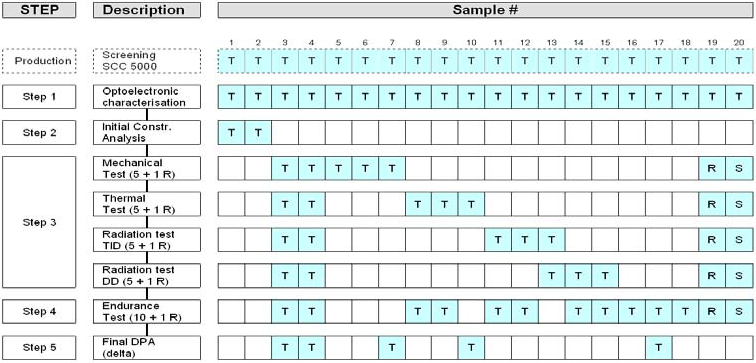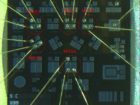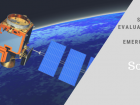Evaluation of 2.1μm DFB Lasers for Space Applications

SWIR wavelength variation (dark blue line; right axis) with ambient temperature cycling for a laser diode TEC controlled temperature of 20ºC (light blue line). The red line is the actual chamber temperature and the purple line is the laser package temperature measured with an additional thermocouple.
Introduction
To understand the evaluation of 2.1μm DFB lasers for space applications is important to know more about semiconductor lasers (or laser diodes) operating in the wavelength region of 1.8 µm to 3 µm are attractive light sources for applications including remote sensing, laser spectroscopy or pollutant detection. Highly strained InGaAs Quantum Wells (QW) grown on InP substrates can operate up to wavelengths slightly higher than 2 µm. GaInAsSb active layers on GaSb substrates have potential emission in the 1.7-3.5 µm range.
GaSb based DFB lasers emitting at 2 µm were reported for the first time by the University of Würzburg in 2001 [1]. They achieved room temperature emission with output powers up to 10 mW and Side Mode Suppression Ratio (SMSR) of 31 dB. DFB laser diodes can additionally be tuned by changing the operation temperature and the driving current, as a consequence of the dependence of the effective refractive index on temperature.
This makes this type of source a potential candidate for space applications and first results of investigated fibrecoupled Butterfly type devices emitting in the 2.1µm wavelength range for applications in a space environment will be described in this contribution.
In this evaluation has been workign together Alter Technology Group Spain, the Universidad Politécnica de Madrid (Spain), ETSI Telecommunicación, nanoplus GmbH, Nanosystems and Technologies Oberer Kirschberg (Germany) & the European Space Agency, ESTEC Keplerlaan, Netherlands. This paper presents the results obtained in the frame of an ESA-funded project called “Screening and Preevaluation of Shortwave Infrared Laser Diode for Space Application” with the objective of verifying the maturity of state of the art SWIR DFB lasers at 2.1µm to be used for space applications (mainly based on the occultation measurement principle and spectroscopy). The paper focus on the functional and environmental evaluation test plan. It includes high precision characterization, mechanical test (vibration and SRS shocks), thermal cycling, gamma and proton radiation tests, life test and some details of the Destructive Physical Analysis performed. The electro-optical characterization includes measurements of the tuning capabilities of the laser both by current and by temperature, the wavelength stability and the optical power versus laser current.
Main Results

SWIR Laser test flow proposed for 20 samples. (T means sample to be Tested, R means Reference and S means Spare; the samples came from two different lots)
The main results obtained when comparing the results before and after each environmental test are summarized in the following paragraphs:
- Mechanical Subgroup Test results: The samples have supported without degradation the mechanical tests (vibration and SRS shocks).
- Radiation Subgroup Test result: Neither gamma nor proton radiation has affected the lasers.
- Endurance Test results: Several samples are supporting the strong life test conditions without any degradation showing that the technology has the capability to survive the life test requirements, although a better uniformity of the lot manufacturing, if possible, is desirable. Additionally, an early failure and degradation for some of the devices were observed as will be presented in the talk.
- Thermal Subgroup Test results: Analyzed samples showed degradation during thermal cycling affecting output power and tuning characteristics of the devices, but the underlying reason of this behavior is presently not understood and currently investigated further.
- Construction analysis: The Residual Gas Analysis (RGA) showed a certain amount of internal humidity in the package. This can clearly have an impact on device reliability and could also be the underlying reason for the different behavior during endurance testing.
Conclusion
DFB laser diodes based on a laser structure in the AlGaInAsSb/GaSb material system emitting in the 2.1μm wavelength range and integrated in a Butterfly package with an output power of around 10mW ex-fiber are investigated for the first time for applications in a space environment and measurement results of the corresponding test plan (mechanical, thermal, radiation and endurance) are presented.
The required accuracy to control the wavelength is directly coupled with the accuracy of the laser current and of the laser diode temperature. If high accuracy of the wavelength control is needed, then the dependence of the wavelength with ambient temperature that will be always present, even with laser diode temperature control, should be taken into account. No radiation related degradation has been observed. A problem related to thermal cycling is indicated by the results obtained till now; further investigations of this effect (including DPA) are currently being performed. The endurance test results obtained till now (this test continues) shows different behavior for different samples, but seems to show that there are no fundamental reasons that could prevent the use of this technology for space applications.
- Optoelectronic Components for Integration into Space - 1st February 2016
- Extreme Temperature Characterization of Passive Components - 1st February 2016
- Evaluation of the Radiation Hardness of GaSbbased Laser Diodes for Space Applications - 1st February 2016



